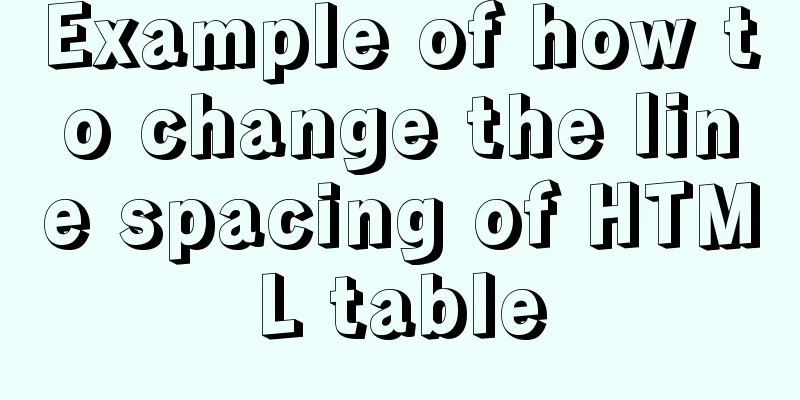js object to achieve data paging effect

|
This article example shares the specific code of js object to achieve data paging effect for your reference. The specific content is as follows To implement data paging, you need to be clear about the design of this aspect: 1. First simulate and establish a backend database , as follows:
var peoson = [
{
"id":"1",
" name":"Ju Jingyi",
"sex":"female",
"age":"25",
"class":"Class 8",
"habby":"dancing",
"score":"40",
"addess":"Chang'an District, Xi'an, Shaanxi"
},
{
"id":"2",
" name":"Guan Xiaotong",
"sex":"female",
"age":"20",
"class":"Class 8",
"habby":"dancing",
"score":"40",
"addess":"Chang'an District, Xi'an, Shaanxi"
},
{
"id":"3",
" name":"Zhao Liying",
"sex":"female",
"age":"26",
"class":"Class 8",
"habby":"dancing",
"score":"40",
"addess":"Chang'an District, Xi'an, Shaanxi"
},
{
"id":"4",
" name":"Xue Zhiqian",
"sex":"male",
"age":"37",
"class":"Class 8",
"habby":"dancing",
"score":"40",
"addess":"Chang'an District, Xi'an, Shaanxi"
}
]2. Set the amount of data per page, the current page number, and the total number of pages Use a function to dynamically set the total number of pages, calculated by dividing the total amount of data by the amount of data per page;
Allpage: function () {
this.allpage = Math.ceil(this.Message.length / this.perpage);
console.log(this.Message.length);
console.log(this.allpage);
},
Nowpagenum:function(n){
var first=(n-1)*this.perpage; //0
var last=n*this.perpage; //10
this.nowpagenum =this.Message.slice(first,last);
},3. Dynamically create DOM elements and add sub-elements to the largest block to store each piece of data
Creatnews:function() {
this.list.innerHTML = "";
for (var i = 0; i < this.perpage; i++) {
var page_list = document.createElement("div");
page_list.className = "pagelist";
for (var key in this.nowpagenum[i]) {
var per_child = document.createElement("div");
per_child.className = "perchild";
page_list.appendChild(per_child);
per_child.innerHTML = this.nowpagenum[i][key];
//console.log(this.nowpagenum[i]);
}
this.list.appendChild(page_list);
}
},4. Create the page numbers below the list, and do front indent, back indent, and front and back indent Assuming the total number of pages is, if the current page number is greater than 5 pages, the front indent will be performed, and the previous page number will be indented from 2 to the current page number minus 1;
Page_ma:function(current,totle){
var str="";
for(var i=1;i <=totle;i++){
if(i==2 && current-3>i ){ //ǰ���� current>5
i=current-1;
str+="<li>...</li>";
}
else if(i==current+4 && current+4<totle){
i=totle-1;
str+="<li>...</li>"; //������ current<16
}
else{
if(current==i){
str+="<li class='minilist' style='background: pink'>"+i+"</li>";
}
else{
str+="<li class='minilist'>"+i+"</li>";
}
}
}
this .pageshu.innerHTML= str;
},5. When you click on a page, it will jump to the data of the current page and indent accordingly
Pageclick:function(){
var mini_list = document.getElementsByClassName ("minilist");
for(var k=0;k <mini_list.length;k++){
mini_list[k].onclick=function(){
Fenye.nowpage = parseInt (this.innerHTML);
// console.log(this.innerHTML); //mini_list[k] �������ı�
Fenye.Page_ma(Fenye.nowpage,Fenye.allpage);
Fenye.Pageclick();
Fenye.Createnews();
Fenye.Nowpagenum (Fenye.nowpage);
}6. When you click on the previous or next page, or set the page number to jump to, it will jump to the data of the current page and indent accordingly.
Clickevent:function(){
Fenye.back.onclick =function(){
Fenye.nowpage--;
if(Fenye.nowpage<2){
Fenye.nowpage=1;
}
Fenye.Page_ma(Fenye.nowpage,Fenye.allpage);
Fenye.Pageclick();
Fenye.Createnews();
Fenye.Nowpagenum (Fenye.nowpage);
};
Fenye.go.onclick = function(){
if(Fenye.nowpage>=Fenye.allpage){
Fenye.nowpage=Fenye.allpage;
}
Fenye.nowpage++;
Fenye.Page_ma(Fenye.nowpage,Fenye.allpage);
Fenye.Pageclick();
Fenye.Createnews();
Fenye.Nowpagenum (Fenye.nowpage);
};
Fenye.tiao.onclick = function(){
var put = document.getElementById ("in_put");
Fenye.nowpage = parseInt (put.value ) ;
if(put.value>=Fenye.allpage){
Fenye.nowpage = parseInt (put.value );
}
Fenye.Page_ma(Fenye.nowpage,Fenye.allpage);
Fenye.Pageclick();
Fenye.Createnews();
Fenye.Nowpagenum (Fenye.nowpage);
}
}HTML and CSS parts
<!DOCTYPE html>
<html>
<head lang="en">
<meta charset="UTF-8">
<title></title>
<script src="js/message1.js" type="text/javascript"></script>
<script src="js/pagenews.js" type="text/javascript"></script>
<style>
*{
margin:0;
padding:0;
}
li{
list-style: none;
}
.block{
position: relative;
width:1200px;
height:600px;
margin:auto;
border:1px solid darkblue;
}
.totle {
width:100%;
height:40px;
display: flex;
flex-direction: row;
flex:1;
background: #b0ffd8;
text-align: center;
color: #5c5a5c;
font-size: 18px;
line-height: 40px;
}
.tot_1 {
flex: 1;
}
.tot_2{
flex:2.5;
}
.list{
width:1200px;
height:auto;
}
.pagelist{
width:100%;
height:35px;
border-bottom: 1px solid silver;
display: flex;
flex-direction: row;
text-align: center;
}
.perchild:nth-child(1) {
flex:1;
}
.perchild:nth-child(2) {
flex:1;
}
.perchild:nth-child(3) {
flex:1;
}
.perchild:nth-child(4) {
flex:1;
}
.perchild:nth-child(5) {
flex:1;
}
.perchild:nth-child(6) {
flex:1;
}
.perchild:nth-child(7) {
flex:1;
}
.perchild:nth-child(8) {
flex:2.5;
background: pink ;
}
.footer{
position: absolute;
bottom:5px;
left:10px;
}
#pageshu>li{
width:35px;
height:35px;
line-height: 35px;
display: inline-block;
text-align: center;
border:1px solid gray;
}
#back, #go{
width:60px;
height:35px;
line-height: 35px;
border:1px solid black;
display: inline-block;
text-align: center;
}
#foot_li>li:nth-child(2), #foot_li>li:nth-child(4), #foot_li>li:nth-child(5),#foot_li>li:nth-child(6){
display: inline-block;
}
#foot_li>li:nth-child(4)>input{
width:30px;
height:20px;
outline: none;
}
#foot_li>li:nth-child(5)>button{
background: #000bff;
color: #fff;
}
</style>
</head>
<body>
<div class="block">
<div class="totle">
<div class="tot_1">Student ID</div>
<div class="tot_1">Name</div>
<div class="tot_1">Gender</div>
<div class="tot_1">Age</div>
<div class="tot_1">Class</div>
<div class="tot_1">Hobbies</div>
<div class="tot_1">Credits</div>
<div class="tot_2">Home address</div>
</div>
<div class="list">
</div>
<div class="footer">
<ul id="foot_li">
<li id="back">Previous page</li>
<li>
<ul id="pageshu">
</ul>
</li>
<li id="go">Next page</li>
<li>Jump to <input id="in_put" type="text"/> </li>
<li><button id="tiao">Jump</button></li>
<li>Total Pages:<span id="tot"></span></li>
</ul>
</div>
</div>
</body>
</html>The above is the full content of this article. I hope it will be helpful for everyone’s study. I also hope that everyone will support 123WORDPRESS.COM. You may also be interested in:
|
<<: How to modify the sources.list of Ubuntu 18.04 to Alibaba or Tsinghua mirror
>>: MySQL implements an example method of logging in without a password
Recommend
Javascript File and Blob Detailed Explanation
Table of contents File() grammar parameter Exampl...
Detailed explanation of tinyMCE usage and experience
Detailed explanation of tinyMCE usage initializat...
Linux sftp command usage
Concept of SFTP sftp is the abbreviation of Secur...
Detailed explanation of the solution to the nginx panic problem
Regarding the nginx panic problem, we first need ...
Detailed explanation of MYSQL database table structure optimization method
This article uses an example to illustrate the me...
Record the whole process of MySQL master-slave configuration based on Linux
mysql master-slave configuration 1. Preparation H...
Detailed introduction to JS basic concepts
Table of contents 1. Characteristics of JS 1.1 Mu...
JavaScript canvas to achieve raindrop effects
This article example shares the specific code of ...
Detailed explanation of monitoring NVIDIA GPU usage under Linux
When using TensorFlow for deep learning, insuffic...
Vue implements click feedback instructions for water ripple effect
Table of contents Water wave effect Let's see...
Vue implements top left and right sliding navigation
Navigation and other things are often used in dai...
Summary of Linux file directory management commands
touch Command It has two functions: one is to upd...
How to install and uninstall open-vswitch in Linux
1. Compile and install ovs from source code: Inst...
Detailed explanation of how to dynamically enable/disable hyperthreading technology in Linux
Preface Intel's hyper-threading technology al...
A complete guide to Linux environment variable configuration
Linux environment variable configuration When cus...









